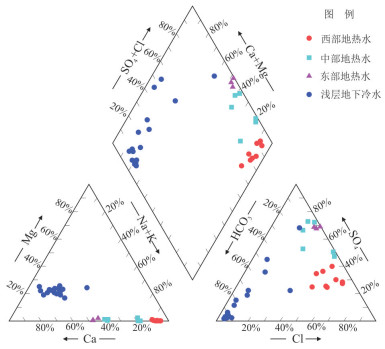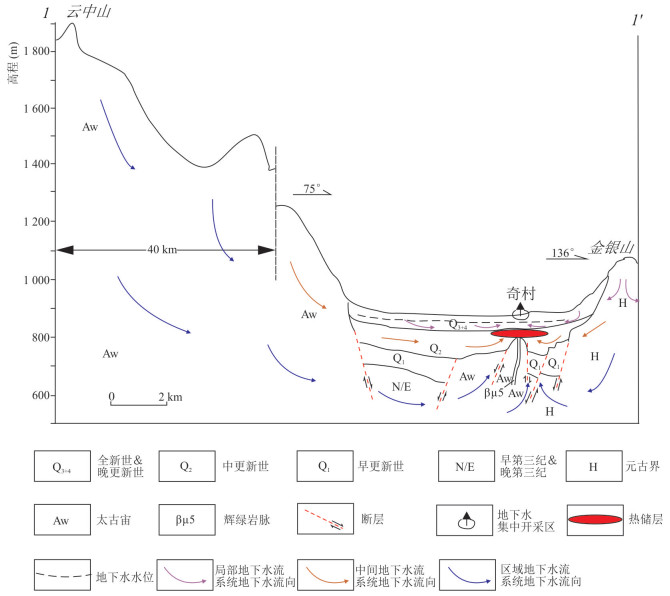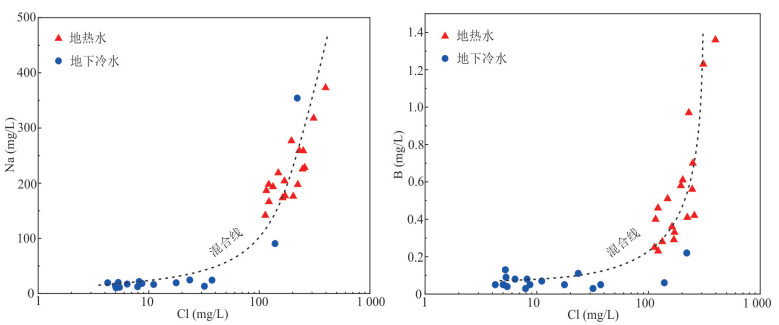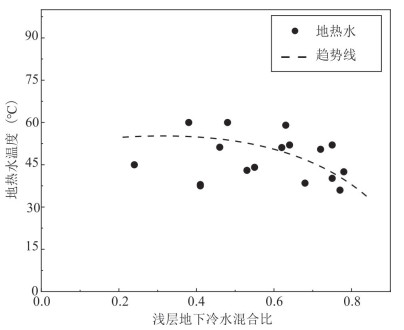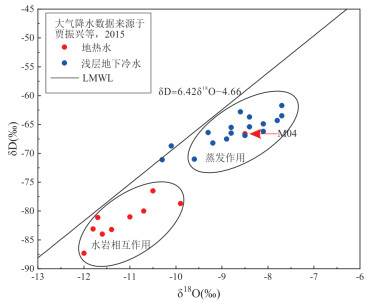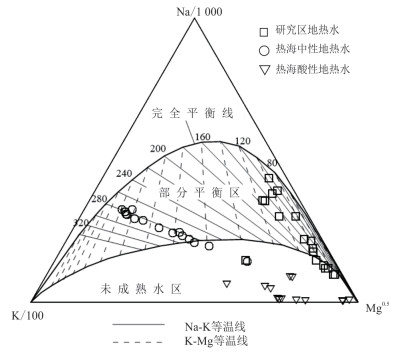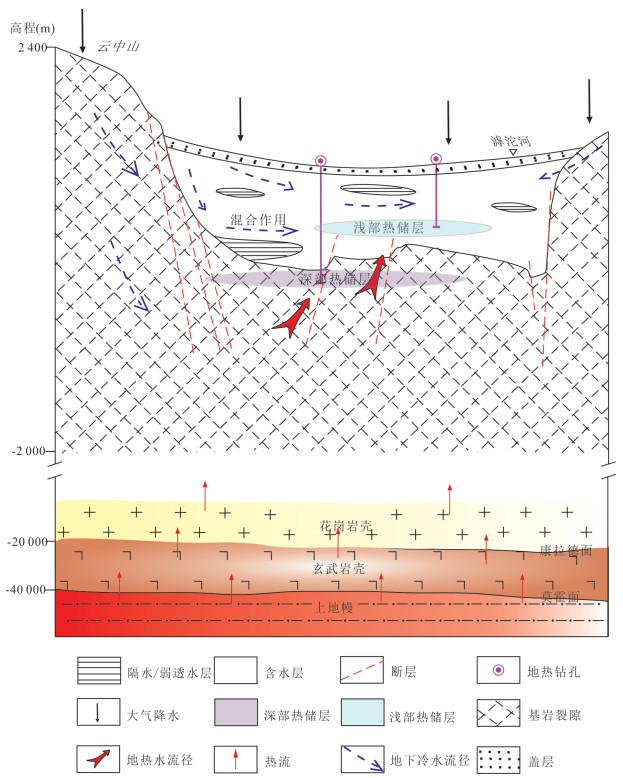Geochemical Characteristics and Formation Mechanisms of the Geothermal Waters in the Xinzhou Basin, Shanxi Province
-
摘要: 地热水地球化学研究对于认识各类水热型地热资源的成因机制有重要意义.以山西忻州盆地为研究区,开展了系统的地球化学研究.结果显示,忻州盆地地热系统的形成与地壳浅部岩浆房和浅部岩石放射性元素衰变热异常无关,而是正常热流背景下地下水深循环的结果.地热水的水化学和氢氧同位素特征均指示区内地热水补给来源于西部云中山区大气降水,大气降水由补给区入渗并向东部忻州盆地运移,循环深度为1 618.3~3 451.5 m,热储温度达48.4~91.8 ℃.地热水上升至第四系孔隙热储后普遍混入浅层地下冷水,最高混合比可达78%.Abstract: Studies on geothermal water geochemistry are of great significance for understanding the genesis of various hydrothermal resources. By taking the Xinzhou basin in Shanxi Province as a study area, this paper aims to identify the geochemical origin of the Xinzhou geothermal waters, to evaluate the mixing process between the geothermal waters and the shallow cold groundwaters, and to reveal the geological genesis of the Xinzhou geothermal system based on a systematic geochemical study conducted there. The formation of the Xinzhou geothermal system should have nothing to do with a shallow magma chamber or excessive decay heat of radioactive elements in shallow rocks. Instead, it occurred as a result of the deep groundwater circulation in a normal heat flow background. The atmospheric precipitation in the western Yunzhongshan recharge area infiltrated into the deep underground and migrated to the Xinzhou basin with circulation depths between 1 618.3 and 3 451.5 m. Correspondingly, the reservoir temperatures ranged from 48.4 to 91.8 ℃. The geothermal waters were mixed substantially with the shallow groundwaters when ascending to the Quaternary aquifers, the highest mixing ratio being up to 78 %.
-
Key words:
- geothermal water /
- geochemistry /
- reservoir temperature /
- heat source /
- Xinzhou basin
-
图 1 忻州盆地地质简图与采样点位置(改自Han et al., 2010b)
①云中山东麓断裂;②系舟山北麓断裂;③五台山北麓断裂;④恒山南麓断裂
Fig. 1. Geological map of Xinzhou basin and sampling locations (after Han et al., 2010b)
图 11 忻州盆地地热系统成因机制概念模型(改自刘明亮等, 2020)
Fig. 11. Conceptual model of formation mechanism of Xinzhou basin geothermal system (after Liu et al., 2020)
表 1 忻州盆地地下水样品现场测试指标
Table 1. In-situ parameters of water samples from Xinzhou basin
编号 采样点位置 采样深度(m) 取水地层 pH T(℃) EC(μs/cm) TDS (mg/L) Eh (mV) W01 北合索村 260 太古界 8.7 50.5 1 022 501.5 24.7 W02 北合索村 264 太古界 8.8 59.0 1 219 597.7 5.1 W03 东呼延村 270 太古界 8.7 52.0 971 476.4 -107.7 W04 奇村 150 第四系 8.7 60.0 1 584 776.7 -45.5 W05 奇村 180 第四系 8.3 42.5 851 417.4 76.3 W06 奇村 62 第四系 8.6 60.0 1 686 826.7 12.2 W07 奇村 50 第四系 8.8 43.0 1 253 614.5 -123.5 W08 奇村 - 第四系 8.4 51.1 1 106 542.6 67.4 W09 奇村 120 第四系 8.7 52.0 1 678 822.9 55.4 M01 顿村 337 元古界 7.6 40.2 1 607 787.9 -33.6 M02 前秦村 377 元古界 7.7 38.5 1 867 915.2 68.0 M03 北赵村 1 040 元古界 8.1 44.1 2 193 1 075.0 -115.6 M04 云中河南岸 1 868 元古界 8.3 36.0 1 252 614.1 -286.1 M05 逯家庄村 450 元古界 8.9 37.5 1 891 926.9 -34.7 M06 卢野村 470 元古界 9.0 38.0 1 605 786.8 -57.9 E01 上汤头村 59 第四系 8.0 57.0 3 270 1 603.0 41.6 E02 上汤头村 58 第四系 7.6 51.2 3 297 1 616.0 89.4 E03 上汤头村 72 第四系 7.7 45.0 2 813 1 379.0 74.2 CG01 南岗村 - 第四系 7.9 18.7 389 191.0 164.0 CG02 上院村 55 第四系 7.2 12.5 771 378.0 215.0 CG03 上院村 55 第四系 7.6 13.5 433 212.0 214.0 CG04 上院村 60 第四系 7.7 13.1 459 225.0 209.0 CG05 上院村 185 第四系 7.6 14.3 729 358.0 121.0 CG06 上院村 160 第四系 7.8 14.0 418 205.0 118.0 CG07 中三泉村 - 第四系 7.7 11.0 356 175.0 238.0 CG08 中三泉村 30 第四系 7.2 11.8 1 503 737.0 189.0 CG09 中三泉村 - 第四系 7.7 12.1 402 198.0 219.0 CG10 中三泉村 180 第四系 8.1 11.5 385 189.0 224.0 CG11 北岗村 170 第四系 7.7 12.7 525 258.0 85.0 CG12 北贾村 27 第四系 7.8 9.8 884 434.0 179.0 CG13 尚家庄村 120 第四系 7.9 12.0 515 253.0 85.0 CG14 施家野庄村 120 第四系 7.5 10.1 1 158 568.0 33.0 CG15 唐林岗村 50 第四系 7.3 9.3 3 937 1 930.0 143.0 CG16 桃园村 140 第四系 7.9 13.1 488 240.0 128.0 CG17 西常村 120 第四系 7.9 11.0 463 227.0 109.0 表 2 忻州盆地花岗岩样品的U、Th、K含量及放射性生热率
Table 2. U, Th, K compositions and the radiogenic heating rate of granite samples from Xinzhou basin
样品编号 采样地点 岩石类型 K(%) Th(μg/g) U(μg/g) 生热率A(μW/m3) L03 莲花山 花岗岩 4.37 23.13 2.29 2.60 L04 莲花山 花岗岩 3.70 27.51 3.49 3.15 L05 莲花山 花岗岩 3.77 28.12 3.84 3.29 G01 于家沟 花岗岩 4.90 27.00 2.06 2.86 G04 于家沟 花岗岩 0.79 17.40 6.24 2.88 表 3 忻州盆地地热水氢氧同位素数据及补给高程计算结果
Table 3. Hydrogen and oxygen isotope data and recharge elevation of geothermal water samples from Xinzhou basin
编号 实测数据 冷水混合前 采样点高程(m) 补给高程(m) δD(‰) δ18O(‰) δD(‰) δ18O(‰) W02 -84.0 -11.6 -110.1 -14.2 840 3 194 W03 -83.1 -11.8 -126.3 -16.9 833 3 837 W04 -80.0 -10.7 -90.4 -11.3 832 2 401 W06 -81.0 -11.0 -88.5 -11.6 836 2 330 M01 -76.5 -10.5 -99.9 -11.7 831 2 779 M02 -78.7 -9.9 -100.0 -9.5 798 2 748 M03 -83.2 -11.4 -100.9 -13.0 790 2 779 M04 -66.6 -8.5 -59.6 -3.1 787 1 122 M06 -87.3 -12.0 -100.2 -13.3 789 2 750 E01 -81.1 -11.7 -81.1 -11.7 768 1 964 表 4 忻州盆地热储温度和地热水循环深度
Table 4. Reservoir temperatures and circulation depth of Xinzhou basin
编号 井口温度(℃) 热储玉髓温度(℃) 循环深度(m) W01 50.5 79.6 2 937.6 W02 59.0 84.7 3 152.8 W03 52.0 72.1 2 618.0 W04 60.0 90.8 3 409.2 W05 42.5 74.7 2 728.9 W06 60.0 91.4 3 435.5 W07 43.0 67.6 2 430.2 W08 51.1 91.8 3 451.5 W09 52.0 91.2 3 424.4 M01 40.2 64.6 2 301.8 M02 38.5 63.5 2 256.6 M03 44.1 70.2 2 537.6 M04 36.0 48.4 1 618.3 M05 37.5 59.8 2 100.7 M06 38.0 61.2 2 159.8 E01 57.0 78.7 2 896.0 E02 51.2 81.0 2 996.1 E03 45.0 80.2 2 960.8 注:热储玉髓温度据 Arnórsson et al. (1983) .表 5 忻州盆地地热水相对各种矿物的饱和指数
Table 5. The saturation indices of geothermal water relative to various minerals in Xinzhou basin
编号 玉髓 石英 钾云母 方解石 文石 硬石膏 石膏 萤石 钠长石 滑石 白云石 W01 0.19 0.54 3.20 0.23 0.11 -2.43 -2.37 -0.09 -0.67 4.94 -0.69 W02 0.12 0.45 2.85 0.23 0.11 -2.20 -2.21 0.03 -0.81 5.33 -1.10 W03 0.10 0.45 3.08 0.47 0.34 -2.35 -2.30 -0.06 -0.95 5.34 -0.14 W04 0.18 0.51 2.81 0.34 0.22 -2.15 -2.17 0.05 -0.84 5.20 -1.02 W05 0.27 0.65 5.41 0.21 0.08 -2.48 -2.36 -0.11 -0.34 3.76 -0.33 W06 0.20 0.53 3.49 0.34 0.22 -2.02 -2.04 0.06 -0.60 4.63 -1.10 W07 0.15 0.53 5.06 0.43 0.30 -2.22 -2.10 0.13 -0.56 5.59 -0.20 W08 0.32 0.68 4.56 0.41 0.28 -2.24 -2.18 -0.03 -0.32 5.79 0.03 W09 0.27 0.62 4.23 0.47 0.34 -2.46 -2.41 -0.19 -0.30 4.64 -0.62 M01 0.22 0.60 7.51 0.24 0.11 -1.08 -0.94 0.08 -0.14 -0.32 -0.81 M02 0.23 0.62 7.66 0.13 0.00 -0.94 -0.79 0.18 -0.04 0.18 -1.04 M03 0.22 0.60 6.27 0.28 0.15 -0.82 -0.71 0.17 -0.05 2.36 -1.11 M04 0.08 0.48 6.45 0.54 0.41 -1.67 -1.51 -0.15 -0.34 3.43 0.40 M05 0.13 0.52 4.10 0.34 0.21 -1.61 -1.45 0.57 -0.47 3.00 -1.52 M06 0.12 0.51 4.45 0.31 0.17 -1.48 -1.32 0.58 -0.26 3.58 -1.69 E01 0.17 0.51 5.70 0.14 0.01 -0.36 -0.36 0.29 -0.19 3.21 -1.62 E02 0.26 0.62 6.51 0.25 0.13 -0.69 -0.64 0.00 -0.20 2.40 -0.57 E03 0.32 0.69 7.20 0.38 0.25 -0.58 -0.47 0.11 0.20 0.93 -0.93 -
Ármannsson, H., 2016. The Fluid Geochemistry of Icelandic High Temperature Geothermal Areas. Applied Geochemistry, 66: 14-64. https://doi.org/10.1016/j.apgeochem.2015.10.008 Arnórsson, S., Gunnlaugsson, E., Svavarsson, H., 1983. The Chemistry of Geothermal Waters in Iceland. Ⅲ. Chemical Geothermometry in Geothermal Investigations. Geochimica et Cosmochimica Acta, 47: 567-577. https://doi.org/10.1016/0016-7037(83)90278-8 Bai, D. H., Liao, Z. J., Zhao, G. Z., et al., 1994. Inferred Magma Heat Source from MT Detection Results in Tengchong Rehai Hot Field. Chinese Science Bulletin, 39(4): 344-347 (in Chinese). doi: 10.1360/csb1994-39-4-344 Chen, M. X., 1988. Geothermics in North China. Science Press, Beijing (in Chinese). Clark, I. D., 1998. Environmental Isotopes in Hydrogeology: Boca. Lewis Publishers, Boca Raton. Dai, W., Jiang, X. W., Luo, Y. F., et al., 2021. Identification and Quantification of Factors Controlling Hydrogen and Oxygen Isotopes of Geothermal Water: an Example from the Guide Basin, Qinghai Province. Earth Science Frontiers, 28(1): 420-427 (in Chinese with English abstract). Deng, A. L., Sun, H. P., 2002. Discussion on Hydraulic Loading and Effluent Effect in Wastewater Infiltration land Treating Systems. Earth Science, 27(2): 134, 208 (in Chinese with English abstract). doi: 10.3321/j.issn:1000-2383.2002.02.024 Guo, Q. H., 2012. Hydrogeochemistry of High-Temperature Geothermal Systems in China: A Review. Applied Geochemistry, 27(10): 1887-1898. https://doi.org/10.1016/j.apgeochem.2012.07.006 Guo, Q. H., 2020. Magma-Heated Geothermal Systems and Hydrogeochemical Evidence of Their Occurrence. Acta Geologica Sinica, 94(12): 3544-3554 (in Chinese with English abstract). doi: 10.3969/j.issn.0001-5717.2020.12.002 Guo, Q. H., Liu, M. L., Li, J. X., et al., 2014. Acid Hot Springs Discharged from the Rehai Hydrothermal System of the Tengchong Volcanic Area (China): Formed via Magmatic Fluid Absorption or Geothermal Steam Heating? Bulletin of Volcanology, 76(10): 1-12. https://doi.org/10.1007/s00445-014-0868-9 Guo, Q. H., Wang, Y. X., 2012. Geochemistry of Hot Springs in the Tengchong Hydrothermal Areas, Southwestern China. Journal of Volcanology and Geothermal Research, 215-216: 61-73. https://doi.org/10.1016/j.jvolgeores.2011.12.003 Han, D. M., 2007. Analysis of Groundwater Flow System and Modeling of Hydrogeochemical Evolution in Xinzhou Basin, China (Dissertation). China University of Geosciences, Wuhan (in Chinese with English abstract). Han, D. M., Liang, R., Currell, R. J., et al., 2010a. Environmental Isotopic and Hydrochemical Characteristics of Groundwater Systems in Daying and Qicun Geothermal Fields, Xinzhou Basin, Shanxi, China. Hydrological Processes, 24(22): 3157-3176. https://doi.org/10.1002/hyp.7742 Han, D. M., Liang, X., Jin, M. G., et al., 2010b. Evaluation of Groundwater Hydrochemical Characteristics and Mixing Behavior in the Daying and Qicun Geothermal Systems, Xinzhou Basin. Journal of Volcanology and Geothermal Research, 189(1-2): 92-104. https://doi.org/10.1016/j.jvolgeores.2009.10.011 Huang, W. X., 2005. Conceptual Model of Qicun Geothermal Field in Xinzhou, Shanxi Province. Huabei Natural Resources, (6): 15-18 (in Chinese). Huang, W. X., Yang, Q. M., 2003. Discussion on Geothermal Resources in Shanxi Province. Shanxi Energy and Energy Conservation, (1): 46-47, 49 (in Chinese). Jia, Z. X., Zang, H. F., Zheng, X. Q., et al., 2015. Research on Characteristics of Hydrogen and Oxygen Isotopes of Precipitation in Taiyuan Area. Journal of Water Resources and Water Engineering, 26(2): 22-25 (in Chinese with English abstract). Kong, Y. L., Pang, Z. H., Shao, H. B., et al., 2014. Recent Studies on Hydrothermal Systems in China: A Review. Geothermal Energy, 2(1): 1-12. https://doi.org/10.1186/s40517-014-0019-8 Li, Q. L., 1996. Some Characteristics of the Geothermal Distribution in Shanxi Rift Zone. Earthquake Research in Shanxi, (1): 26-30 (in Chinese with English abstract). Li, Y. G., Lin, W. J., Xing, L. X., et al., 2021. Estimation of Deep Geothermal Reservoir Temperature in Qabqa Area, Qinghai Province. Geology and Resources, 30(4): 479-484, 511 (in Chinese with English abstract). Liu, M. L., He, T., Wu, Q. F., et al., 2020. Hydrogeochemistry of Geothermal Waters from Xiongan New Area and Its. Earth Science, 45(6): 2221-2231 (in Chinese with English abstract). Lu, L. H., Pang, Z. H., Kong, Y. L., et al., 2018. Geochemical and Isotopic Evidence on the Recharge and Circulation of Geothermal Water in the Tangshan Geothermal System near Nanjing, China: Implications for Sustainable Development. Hydrogeology Journal, 26(5): 1705-1719. https://doi.org/10.1007/s10040-018-1721-6 Ni, S. B., Man, F. S., Wang, Z. R., et al., 1999. Characteristics of Heat Production Distribution in Northern Xinjiang. Journal of University of Science and Technology of China, 29(4): 408-414 (in Chinese with English abstract). Rollinson, H., 1993. Using Geochemical Data: Evaluation, Presentation, Interpretation. Longman Scientific and Technical, London. Rybach, L., 1976. Radioactive Heat Production in Rocks and Its Relation to other Petrophysical Parameters. Pure and Applied Geophysics, 114(2): 309-317. https://doi.org/10.1007/BF00878955 Shangguan, Z. G., Bai, C. H., Sun, M. L., 2000. Mantle-Derived Magmatic Gas Releasing Features at the Rehai Area, Tengchong County, Yunnan Province, China. Science in China (Series D), 30(4): 407-414 (in Chinese). Shangguan, Z. G., Sun, M. L., Li, H. Z., 1999. Active Types of Modern Geothermal Fluids at the Tengchong Region, Yunnan Province. Seismology and Geology, 21(4): 436-442 (in Chinese with English abstract). doi: 10.3969/j.issn.0253-4967.1999.04.020 Wang, D. C., Zhang, R. Q., Shi, Y. H., et al., 1995. General Hydrogeology. Geological Publishing House, Beijing (in Chinese). Wang, J. X., 2014. Evaluation on Geothermal Resource of Xinzhou Qicun (Dissertation). China University of Geosciences, Beijing (in Chinese with English abstract). Xiao, J. H., Zhang, R. F., 2005. Characteristics of Hydrogeochemistry of Geothermal Field of Qi Village, Shanxi, and Earthquake Monitoring. Earthquake Research in Shanxi, (1): 12-14 (in Chinese with English abstract). doi: 10.3969/j.issn.1000-6265.2005.01.005 Yuan, J. F., 2013. Hydrogeochemistry of the Geothermal Systems in Coastal Areas of Guangdong Province, South China (Dissertation). China University of Geosciences, Wuhan (in Chinese with English abstract). Zhang, P., 2017. Hydrochemical Characteristics and Water Rock Interaction of Arxan Springs (Dissertation). China University of Geosciences, Bejing (in Chinese with English abstract). Zhang, S. M., Ren, J. J., Luo, M. H., et al., 2008. Stepwise Landforms and Quaternary Episodic Uplifts of Mountains around Xinding Basin. Seismology and Geology, 30(1): 187-201 (in Chinese with English abstract). doi: 10.3969/j.issn.0253-4967.2008.01.013 Zhang, W., Wang, G. L., Liu, F., et al., 2019. Characteristics of Geothermal Resources in Sedimentary Basins. Geology in China, 46(2): 255-268 (in Chinese with English abstract). Zhu, X., Wang, G. L., Ma, F., et al., 2021. Hydrogeochemistry of Geothermal Waters from Taihang Mountain-Xiongan New Area and Its Indicating Significance. Earth Science, 46(7): 2594-2608 (in Chinese with English abstract). 白登海, 廖志杰, 赵国泽, 等, 1994. 从MT探测结果推论腾冲热海热田的岩浆热源. 科学通报, 39(4): 344-347. https://www.cnki.com.cn/Article/CJFDTOTAL-KXTB199404017.htm 陈墨香, 1988. 华北地热. 北京: 科学出版社. 戴蔓, 蒋小伟, 罗银飞, 等, 2021. 地热水氢氧同位素控制因素识别与定量计算: 以青海贵德盆地为例. 地学前缘, 28(1): 420-427. https://www.cnki.com.cn/Article/CJFDTOTAL-DXQY202101040.htm 邓安利, 孙和平, 2002. 山西省奇村地热田超采引起的热水动态变化. 地球科学, 27(2): 134, 208. doi: 10.3321/j.issn:1000-2383.2002.02.024 郭清海, 2020. 岩浆热源型地热系统及其水文地球化学判据. 地质学报, 94(12): 3544-3554. doi: 10.3969/j.issn.0001-5717.2020.12.002 韩冬梅, 2007. 忻州盆地第四系地下水流动系统分析与水化学场演化模拟(博士学位论文). 武汉: 中国地质大学. 黄卫星, 2005. 山西忻州奇村地热田的概念模型. 华北国土资源, (6): 15-18. https://www.cnki.com.cn/Article/CJFDTOTAL-HBGT200506004.htm 黄卫星, 杨亲民, 2003. 山西省地热资源探讨. 山西能源与节能, (1): 46-47, 49. https://www.cnki.com.cn/Article/CJFDTOTAL-SXJL200301020.htm 贾振兴, 臧红飞, 郑秀清, 等, 2015. 太原地区大气降雨的氢氧同位素特征研究. 水资源与水工程学报, 26(2): 22-25. https://www.cnki.com.cn/Article/CJFDTOTAL-XBSZ201502005.htm 李清林, 1996. 山西断陷带地热分布的某些特征. 山西地震, (1): 26-30. https://www.cnki.com.cn/Article/CJFDTOTAL-SXDZ601.006.htm 李永革, 蔺文静, 邢林啸, 等, 2021. 青海省恰卜恰地区深部热储温度估算. 地质与资源, 30(4): 479-484, 511. https://www.cnki.com.cn/Article/CJFDTOTAL-GJSD202104010.htm 刘明亮, 何曈, 吴启帆, 等, 2020. 雄安新区地热水化学特征及其指示意义. 地球科学, 45(6): 2221-2231. doi: 10.3799/dqkx.2019.270 倪守斌, 满发胜, 王兆荣, 等, 1999. 新疆北部地区岩石生热率分布特征. 中国科学技术大学学报, 29(4): 408-414. https://www.cnki.com.cn/Article/CJFDTOTAL-ZKJD199904004.htm 上官志冠, 白春华, 孙明良, 2000. 腾冲热海地区现代幔源岩浆气体释放特征. 中国科学(D辑), 30(4): 407-414. https://www.cnki.com.cn/Article/CJFDTOTAL-JDXK200004009.htm 上官志冠, 孙明良, 李恒忠, 1999. 云南腾冲地区现代地热流体活动类型. 地震地质, 21(4): 436-442. https://www.cnki.com.cn/Article/CJFDTOTAL-DZDZ199904019.htm 王大纯, 张人权, 史毅红, 等, 1995. 水文地质学基础. 北京: 地质出版社. 王俊鑫, 2014. 忻州市奇村地热资源评价(硕士学位论文). 北京: 中国地质大学. 肖建华, 张瑞丰, 2005. 山西奇村地热田水文地球化学特征与地震监测. 山西地震, (1): 12-14. https://www.cnki.com.cn/Article/CJFDTOTAL-SXDZ200501005.htm 袁建飞, 2013. 广东沿海地热系统水文地球化学研究(博士学位论文). 武汉: 中国地质大学. 张鹏, 2017. 阿尔山泉群水化学特征与水岩作用研究(硕士学位论文). 北京: 中国地质大学. 张世民, 任俊杰, 罗明辉, 等, 2008. 忻定盆地周缘山地的层状地貌与第四纪阶段性隆升. 地震地质, 30(1): 187-201. https://www.cnki.com.cn/Article/CJFDTOTAL-DZDZ200801013.htm 张薇, 王贵玲, 刘峰, 等, 2019. 中国沉积盆地型地热资源特征. 中国地质, 46(2): 255-268. https://www.cnki.com.cn/Article/CJFDTOTAL-DIZI201902005.htm 朱喜, 王贵玲, 马峰, 等, 2021. 太行山-雄安新区蓟县系含水层水文地球化学特征及意义. 地球科学, 46(7): 2594-2608. doi: 10.3799/dqkx.2020.207 -
 dqkxzx-48-3-973-附表.docx
dqkxzx-48-3-973-附表.docx

-










 下载:
下载:
